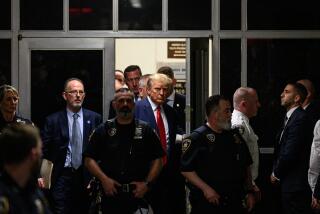Op-Ed: Why monsters, demons and witches are on the ballot this year
Historians are vague about why in 1845 the first Tuesday after the first Monday in November was designated election day. The most specific guess is that in an agrarian society it couldn’t have been on Sunday Sabbath or Wednesday market day — which hardly resolves the question. Every year this seemingly arbitrary congressional decision puts election day close to Halloween, and this year that association has never been more appropriate. Throughout the interminable campaign, images of demons, witches and monsters have been a significant part of rhetoric, primarily from the conspiracy theory-oriented right and left, but also seeping into otherwise rational commentary.
A good chunk of this monster talk began some years ago with the “birther” attack on President Obama’s origins. In contemporary terms the charge was that he was not born in the United States but came from elsewhere — Kenya perhaps — and was part Muslim. But in mythological terms he was therefore the changeling or the demon child, a characterization that carried with it more than a touch of racial prejudice. The invocation of myth strengthened a politics of hostility and fear. Even more recently, a right-wing conspiracy theorist is claiming that Obama and Hillary Clinton stink of sulphur, like demons from hell. The president, the theorist says, is particularly attractive to flies. In case you miss the allusion, it associates him with the Philistine god Beelzebub, Lord of the Flies.
When emotional appeals drown out substantial issues in politics, the recourse to monsters may seem inevitable. During the primaries, David Horsey, the Times editorial cartoonist, wittily cast Donald Trump as the Frankenstein monster and Ted Cruz as Dracula. Since Cruz had already been dubbed the Prince of Darkness by one of his Senate colleagues, the association came easily. In this incarnation, instead of being chased by villagers with torches and pitchforks, the Frankenstein monster now seems to be leading them. To complete this chamber of horrors, Clinton has long been portrayed as a witch, and a recent op ed headline in the Times warned that, if Trump loses the election, “Trumpism may have a zombie life.”
When denouncing an opponent, it’s always persuasive to fit him or her into a pre-existing story, preferably a negative one.
The monster strategy, with its shorthand depictions of dread and terror, has a long history. When denouncing an opponent, it’s always persuasive to fit him or her into a pre-existing story, preferably a negative one.
The kind that works best derives from a source that is deeply etched in the culture, like those emotionally gripping images that come from folklore, fairy tales and religion. The capitalist as a bloodsucking vampire, for example, was as useful a political metaphor for Karl Marx in the 19th century as it had been for Voltaire a hundred years before. In Paris and London, Voltaire wrote in 1764, “stock jobbers, brokers and men of business … sucked the blood of people in broad daylight.” Why go into complicated political or economic arguments when you can more efficiently describe your enemy as a monster?
In contrast with the effort to evoke hostility and demonize your enemy, the film director Guillermo del Toro has said that horror lets us sympathize with the Other, and the monstrous in his films, such as “Pan’s Labyrinth,” can be simultaneously terrifying, comforting and a way into an alternate reality. Certainly the poignant Frankenstein monster, pleading to be understood and loved, is an example of the sympathetic monster.
But the monster stories being invoked in the 2016 campaign are usually much more negative, unless the monster happens to be on your side — like the Golem, the crude, lurching (but sometimes protective) monster from Jewish folklore, to which the looming Trump in the second debate bore an uncanny resemblance. Trump’s “monstrous” behavior gets excoriated by his critics and celebrated (or at least explained away) by his followers. In a similar way, since the “nasty woman” remark in the third debate, Clinton’s supporters have embraced her witchy image and remade it as something positive — an austere Katniss Everdeen in a pantsuit, with a touch of Glinda, the Good Witch of the South.
The invocation of monsters is especially prevalent during periods of fearful change and upheaval. The story of the Golem entered literature from folklore in the early 19th century, along with the beginnings of Jewish political emancipation; Golem films of the early 20th century appeared during a time of widespread antisemitism. Frankenstein, by the same token, reflects an anxiety about science, technology and the modern world that is still with us.
The legendary monsters of the past are shadows in the dark that make a good fit for our unhappy era. To those feeling adrift in a world where there are few if any absolutes, monster images appeal by their seeming simplicity, their guise of inevitability. They offer illusory solace for those who want to feel in the know, for the gullible and naïve, for the cynics who see the dark side of everything, and even for the merely worried.
Amid uncertainty about the present and apprehension for the future, monsters will continue to be ressurrected. But the truly scary part is that we might continue to be unaware of the deep-seated terrors they represent, let alone how easily those fears can influence the way we vote. .
Leo Braudy is a professor of English and American literature at USC. His newest book, “Haunted: On Ghosts, Witches, Vampires, Zombies, and Other Monsters of the Natural and Supernatural Worlds,” was published last week.
To read the article in Spanish, click here
Follow the Opinion section on Twitter @latimesopinion and Facebook
More to Read
A cure for the common opinion
Get thought-provoking perspectives with our weekly newsletter.
You may occasionally receive promotional content from the Los Angeles Times.






